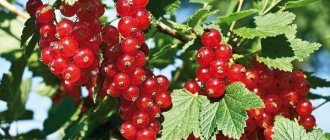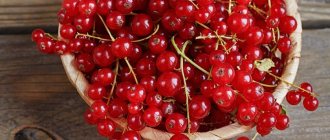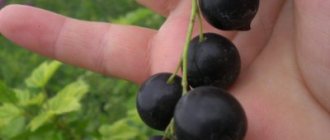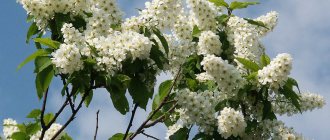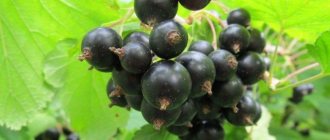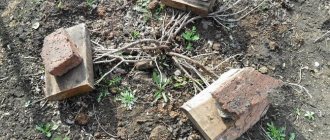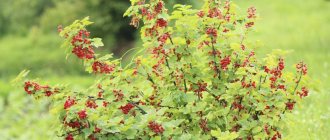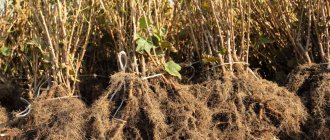Currant Marmaladnitsa was born at the end of the 20th century thanks to the efforts of Bayanova L.V., an employee of the Oryol Institute of Fruit Crop Breeding. The ancestors of the variety were the red currant rootstocks “Rote Spatlese” and “Maarsise Prominente”. The goal of the breeding work was to create a berry bush, the fruits of which would have a high concentration of gelling substances. Test cultivations showed good results, as a result of which an application was submitted to the State Varietal Register for a patent for a red currant variety called “Marmeladnitsa”, which was issued to the institute in December 2001.
The Marmeladnitsa shrub can begin bearing fruit in the first year of planting.
Caring for red currant seedlings
Bushes need regular pruning.
If you do not do this, you will deprive yourself of a significant part of the harvest. In early spring, before new growth begins, starting in the first year after planting, prune and remove all but 6-8 healthy shoots.
In the second year, you leave 4-5 one-year-old shoots and 3-4 two-year-old shoots.
Every spring after this, prune the currant bushes so that they contain 3-4 one-year-old shoots, 3-4 - two-year-old shoots, 3-4 - three-year-old shoots.
Remove all other shoots without sparing. Pruning of mature plants consists of removing all old shoots more than four years old and thinning out some new ones.
White, pink or red currants are easily propagated by cuttings. It is not even necessary to cut them off from the bush - it is enough to bend the branches in the fall, cover them with earth, and in the spring dig them up with the roots. Roots form from contact with the ground. Cut a branch from the mother plant and plant it where you planned.
Red, pink or white currants begin the growing season and enter the flowering phase 5-7 days later than black ones. Flowers are resistant to spring return frosts. It first develops buds and brushes, then leaves bloom. All varieties of this type of currant bloom almost simultaneously. The greatest difference in the timing from the beginning of flowering is 2-3 days. Flowering duration is 12-15 days.
Varieties of red, pink or white currants, as well as black currants, are self-fertile, but with cross-pollination the yield increases. To do this, it is advisable to have several varieties on the site.
The ripening of early varieties of currant berries in Kuban occurs in the first ten days of June. And it ends in late varieties in the first ten days of July. Ripe fruits can hang on the bushes for a long time without falling off or losing their taste. Their coloring is very diverse. Berries come in different shades. The harvest of red, pink or white currants is slightly higher than black currants and is more stable over the years.
They, just like the black one, suffer from heat and drought, although less so. For example, the red currant variety Natalie does not tolerate drought or heat. It reacts to them by shedding ovaries, shrinking berries, and poor formation of flower buds. And the Narodnaya variety tolerates shade well, grows normally, and bears fruit in partial shade.
Read also: Black currant, Variety Veloy (Leningrad sweet) - FGBNU VNIISPK
Most varieties of these types of currants are still light-loving and do not like shading. When irrigated, they produce high yields. Three- or four-year-old bushes can produce 3 to 4 kilograms of berries in the summer season. Once they begin to ripen, you will have to protect them from birds. Covering the bushes with netting can help preserve the crop.
If you want to eat the berries fresh, or use them in jams, syrups, juices, pies, it is best to pick them when they are fully ripe. But if you want to make jellies, it is better to collect them slightly unripe. Unripe berries contain more pectin - the jelly will be strong. Red currant berries gel better than white or pink ones.
Berries can be frozen. Even frozen, they retain their appearance and taste well. In winter, at any time you can prepare excellent vitamin-rich currant juice or compote.
Among pests, aphids can cause serious problems, especially when there are a lot of them. Carefully inspect the leaves of your currant periodically. If aphids are noticed on the bushes, then spraying with any insecticide will help clear them of this pest. Naturally, spraying should be done before setting the berries or after harvesting.
Reviews from gardeners
Galina Alexandrovna
Our family has never been famous for its passion for sweet products, so when choosing currants, it became my goal to choose those that have moderate sweetness. The Marmeladnitsa variety was just right. Every year I harvest a bountiful harvest and make preparations.
Ivan Sergeevich
My Marmalade didn't take root at first. I thought what the problem was, I seemed to fulfill all the conditions. It turned out that I planted it in an area that was too open, so I had to replant the bush in partial shade. I have already planted the following bushes closer to the house, so they produce the largest number of berries per season.
Elena Ivanovna
For a long time I was in search of unpretentious and sour currants, because I love sour varieties. Marmalade was recommended by a neighbor at her summer cottage - she had been growing this variety for 5 years and successfully reaped a large harvest. When I tried this berry, I was delighted and immediately asked for a seedling.
History of selection and description of Marmeladnitsa currant
This variety owes its appearance to the All-Russian Research Institute for Breeding Fruit Crops, which is located in Orel. The author of marmalade currant is Bayanova L.V. The culture was obtained by crossing the varieties Rote Spätlese and Maarsis.
The variety got its name due to the special property of the berry. Its juice easily solidifies even without heating. This happens almost immediately after squeezing. Testing of the variety began in 1996.
Dimensions and branching of the bush
This plant is characterized by a late ripening period. It is characterized by medium bushes that reach 1.5 meters in height. They have a dense, semi-spreading crown. The plant has thick shoots.
The leaves are five-lobed and medium to large in size. They have a rich dark shade and a shiny surface. The bottom of the foliage is covered with a dense layer of fluff. It has sharp and small teeth along the edges.
Flowering and fruiting
The flowers are saucer-shaped. They are found on medium hands measuring 8-10 centimeters. Flowering lasts 10-12 days. First, buds appear on the bushes, after which brushes and foliage form.
The fruits are large in size and flat-round in shape. They weigh 0.4-0.8 grams. Currants are characterized by an orange-red hue and noticeable white veins. The berries come off easily. At the same time, they stay on the bush for quite a long time and do not fall off.
Taste qualities of berries and scope of application
According to the description, the fruits have a sweet and sour taste. According to tasting assessments, they are sour and characterized by a pronounced refreshing taste.
The berries contain a lot of pectin, and therefore have pronounced gelling properties. That’s why they are often used to make jellies, sauces, and preparations. The fruits of this variety are characterized by a high content of ascorbic acid.
Immunity to diseases and insects
The marmalade plant is resistant to bud mites and other common pests. Of the parasites, only aphids are dangerous for bushes. It leads to currant damage due to improper plant care or unfavorable external factors.
The culture is highly immune to many diseases. It practically does not suffer from anthracnose, septoria, or powdery mildew.
Resistance to negative temperatures and drought
Currants easily tolerate lower temperatures without the risk of loss of external characteristics and deterioration in taste. This variety is characterized by average resistance to drought. At the same time, the bushes tolerate heat well.
Advantages and disadvantages
The marmalade maker has the following advantages:
- large berry size;
- the ovaries practically do not crumble, which allows you to harvest a good harvest;
- the plant is resistant to sudden temperature changes and can withstand severe frosts;
- is resistant to parasites;
- the berries tolerate heat well even if the bushes are not irrigated for some time;
- tolerates transportation well without changes in appearance;
- contains a large amount of useful substances;
- fruits have good immunity to various diseases;
- The juice of the berries quickly solidifies without freezing.
Disadvantages of the plant:
- due to improper care, the size of the berries changes, the fruits become small;
- bush trunks require special, careful care;
- a large number of shoots are formed on the bush;
- currants require regular fertilization;
- the sour taste of the fruit, which not everyone likes.
Berry composition
The berries of this variety contain the following components:
- ascorbic acid;
- pectin substances;
- vitamins of group B, A, E, PP;
- minerals, which include calcium, magnesium, phosphorus, sodium, potassium.
Such components are present in red currants in large quantities. The chemical composition of the fruit looks like this:
- amount of sugar – 7%;
- acids – 2.2%.
Nutritional value of fruits:
- carbohydrates – 7.5 g;
- proteins – 0.6 g;
- fats – 0.1 gr.
Fruits are among the low-calorie foods. Calorie content is 33.3 kcal per 100 g of berries.
Application
The fruits are suitable for making jam, compote, syrup, juice. However, they are most often used to make jelly. To do this, juice is squeezed out of the fruit, which can be mixed with sugar. This drink freezes on its own. No additional processing required.
The leaves can be used to make tea. This drink increases the body's defenses and stops the inflammatory process. It is especially useful to use it for colds.
The fruits are also widely used in folk cosmetology:
- The berries are recommended for use as masks for the face and body. This product improves the condition of the epidermis, relieving the skin of inflammation and other problems.
- The fruits can be used for hair. They restore the damaged structure of curls, making the strands soft, smooth, and shiny.
- Red currant juice is recommended for use on nails. It strengthens the nail plate, softens the cuticle, which makes manicure easier.
Read about the use of the Shchedraya currant variety at the link.
Medicinal properties
Red currant berries of this variety have the following medicinal properties:
- thin the blood, which prevents excessive clotting;
- free the body from toxic compounds;
- prevent the occurrence of heart attack and stroke;
- have a positive effect on the condition of the heart;
- prevent the development of atherosclerosis;
- increase the body’s defenses, which helps it resist viral and other similar pathologies;
- improve the condition of the visual organs;
- normalize hormonal levels;
- improve the functioning of the digestive system;
- stop the inflammatory process occurring in the body.
Plant care
The main care of red currants consists of feeding, pruning, watering and cleaning the soil under the bush. The quality of the harvest and the general condition of the plant depend on the timeliness and regularity of these procedures.
Watering
Usually red currants have enough natural precipitation. Additional watering is required during summer drought. Also, to obtain a bountiful harvest, it is recommended to water the bush while the fruit is filling.
Irrigation is carried out in the evening - 20–30 liters of water are poured under each bush. You can use a drip irrigation system.
Trimming
Prune the red currant bush in the spring, before the buds open. Autumn pruning is also possible, but in this case the plant may not survive the winter well.
- In the first year after planting, 5–7 well-developed shoots are left on the bush, and the rest are completely cut off.
- In the second year, 5 one-year shoots and 4 two-year shoots are left.
- In the third year, the bush is formed from 4 one-year, 4 two-year and 4 three-year shoots.
In order for currants to produce a rich harvest with large berries, they must be pruned
Sanitary and thinning pruning is also carried out. Remove damaged, dry and broken branches, cut out weak shoots at the base of the bush. In summer, green shoots are pinched to stimulate the formation of replacement shoots.
Pruning and shaping a red currant bush - video
Top dressing
Red currant Marmaladnitsa is very susceptible to nutritional supplements. As a result of regular application of fertilizers, productivity increases and immunity to diseases and pests increases.
Fertilizer application schedule - table
| Period | Type of feeding | Fertilizers and proportions |
| Early spring | Root | Urea - 25 g per bush. |
| During flowering | Root | Bird droppings are diluted with water 1:15. Consumption - 20 liters per bush. |
| Foliar | Spraying with solutions containing microelements: potassium permanganate, zinc sulfate, ammonium molybdate. | |
| September | Root | 5 kg of cow manure or 7 kg of prefabricated compost per 1 m² of tree trunk area. Organic fertilizers and potassium-phosphorus fertilizers are applied according to the instructions once every 2-3 years. |
Urea is easily absorbed by plants, has a stable form and rapid solubility
Sheltering bushes for the winter
The marmalade plant tolerates frosts well, but it doesn’t hurt to be on the safe side. For successful wintering, the currant bush must first be prepared.
- The hole is cleared of fallen leaves and the soil is thoroughly loosened.
- The area under the bush is mulched with sawdust or spruce branches in a layer of 8–10 cm.
- The branches of the bush are bent to the ground and secured with a weight. These can be boards or logs. The use of metal objects for fixation is strictly prohibited.
A bush prepared in this way tolerates low temperatures well, since the branches are covered even with a very thin layer of snow.
How to properly care for the variety
Comprehensive care for berry crops involves regular watering of the bushes, the use of nutritious fertilizers, crown formation, and protection from frost. The quality of the harvest, the taste characteristics of the berries and the general condition of the plants largely depend on the timeliness and correctness of these procedures.
We organize proper watering
Marmaladnitsa currants, when grown in a temperate climate, have sufficient natural precipitation. Additional soil moisture should be carried out in severe drought conditions. It is also recommended to water the bushes during the period of intensive fruiting. Irrigation is carried out in the evening, after sunset, spending 20-30 liters of water on each bush.
For the convenience of watering plants, you can build a drip irrigation system. To retain moisture in the soil, the tree trunk circle is covered with a layer of mulch.
We carry out formative pruning
It is better to form the crown in the spring, before the buds open. In the first year of seedling development, 5-7 developed shoots are left on them. In the second and subsequent years, 5 annual or more mature shoots are left, and the rest are removed. Branches that are too old, damaged or withered should also be pruned. In summer, young shoots are pinched to stimulate the formation of replacement shoots.
Cod caviar (fresh, canned, salted) - benefits and harm
